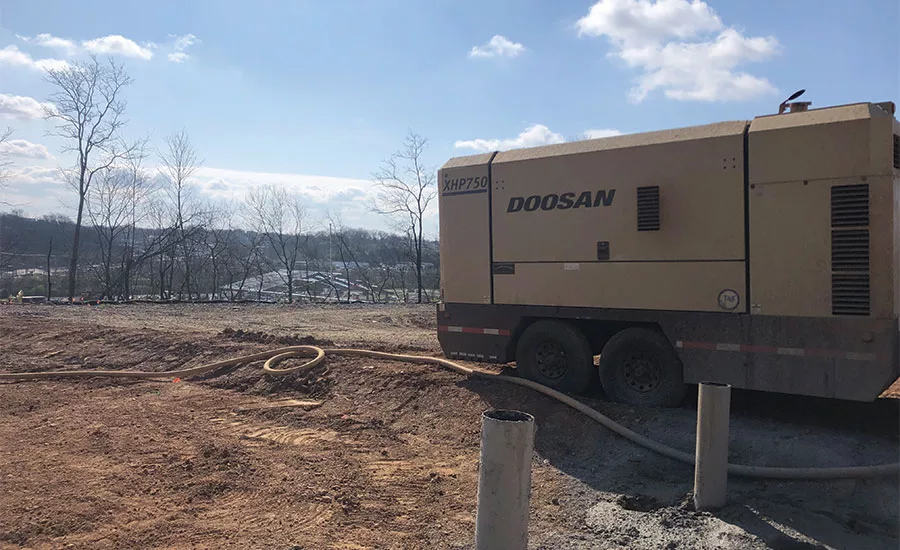Safety, Use Tips: Portable Air Compressors on Drilling Jobs

Do you use supplemental air on the jobsite? Proper positioning, setup and use of portable air compressors is critical.
Source: Doosan Portable Power
Portable air compressors are a familiar piece of equipment in the drilling industry, so much so that many contractors and operators don’t always consider the potential dangers associated with air compressor use. But common misuse and misconceptions about air compressor operation can lead to safety concerns. Learn how to avoid or correct these five misuses of and misconceptions regarding portable air compressors.
Compressed Air is Not Breathable Air
Commercial compressed air has many uses in the drilling industry — sandblasting, powering jackhammers and drill heads — but use as breathable air is not among them. Air discharged from an air compressor can contain mechanical oil, carbon monoxide and other harmful contaminants. Direct or indirect inhalation of air discharged from an air compressor can cause serious injury or death.
A Little Compressed Air Can and Does Hurt
Never use compressed air to clean off dust or debris from clothing and especially bare skin. Never point compressed air at any part of the body or person. Eye and ear injuries can occur easily with careless use of an air compressor. Just 40 pounds of air pressure can rupture an eardrum when released from an air nozzle 4 inches away from the ear.
Not All Hoses are Created Equal
Air compressor hoses need to be specifically rated for the application and suited to handle different variations in pressure and temperature. Improper hoses can explode, rupture or separate from the air connection, putting an operator at risk of physical harm.
After installing proper hoses, ensure whip checks or air flow check valves are used on all pressurized hose applications. Whip checks are steel cables that fit over hose connections with spring-loaded loops to prevent hoses from uncontrollably whipping around in the event of accidental separation during air compressor operation. Air flow check valves use an internal piston to shut off air supply if the air flow volume exceeds a factory preset value. The Occupational Safety and Health Administration (OSHA) requires whip checks or air flow check valves to meet hose restraint compliance. Train operators to do a daily visual inspection of hoses and whip checks before operating the air compressor.
Portable Doesn’t Mean Move By Hand
Despite being on wheels, a portable air compressor should never be moved by hand. This creates an unsafe situation in which the machine has the potential to roll backward or downhill. Always move or reposition a portable air compressor with a towing vehicle, even if it is only a few feet. Place wheel chocks under the air compressor before disconnecting the hitch from the tow vehicle, regardless of surface conditions.
The air compressor should be positioned on as level a surface as possible but also in a well-ventilated area. Ideally, the air compressor should be situated at least 10 feet away from other machines or objects to allow for proper exhaust ventilation and to prevent possible carbon monoxide poisoning.
Let Air In by Keeping Doors Closed
It is a common misconception that an air compressor should be operated with the side doors open to provide more cooling, but the opposite is true. The air compressor is designed to pull air through the intake grill to cool the internal components. The machine cannot properly circulate air with the doors open, and the machine can overheat and shut down.
Keeping the doors closed during operation is also a safety measure to eliminate the potential for burns or other physical harm that could occur from accidental contact with internal components. Operators should become familiar with the machine parts, take note of warning decals and safety guards, and follow the manufacturer’s recommendations for safe operation.
Understanding and avoiding these five common misuses of and misconceptions regarding air compressors can go a long way toward completing one of the most important jobs on a drilling site: working safely.
Looking for a reprint of this article?
From high-res PDFs to custom plaques, order your copy today!





